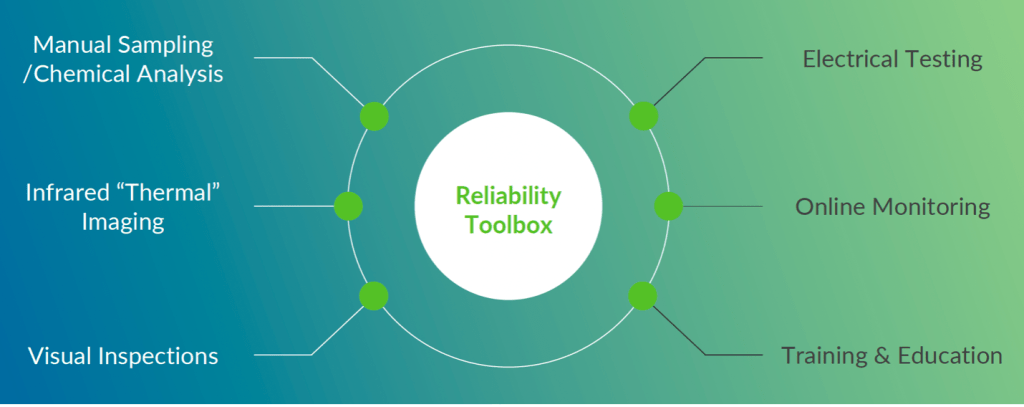Leon White, PE & Traci Hopkins, CRL
The reliability and uptime of electrical transformers is a significant consideration given the essential role they play within the power distribution infrastructure for both electric utilities and large manufacturing facilities.
In general, electrical transformers are very reliable, but they are subject to real-world disturbances where short circuit forces and environmental factors like large load changes and temperature swings reduce the useful life of transformers. When internal damage occurs, the insulating fluid in the cooling system degrades and provides gassing signatures that can be used to prevent power outages or even explosions.
Transformers don’t come with built-in reliability diagnostic systems to alert technicians to health status changes of the system. Thus, we have to turn to a toolbox of proven reliability methods to evaluate transformer health.
What makes this discussion urgent is the aging transformer fleet and the lack of visibility into real-time health of these critical assets. Transformers have an expected lifespan between 30 and 60 years. This is concerning because the average age of transformers in the U.S. is estimated to be in the mid 40 years old.
In a recent webinar (on demand version available here), we discussed the tools that are available to detect transformer issues and maintain these systems in good health.

Common Transformer Reliability Tools
There are six main reliability assurance tools that should be considered for your transformer fleet:
Manual Oil Samples
The first tool is manual sampling of the insulating oil (note that mineral oil is the primary fluid used in most transformers, but other fluids are used including silicone, natural ester and synthetic ester fluids) for chemical analysis. This is a mainstay for transformer reliability and is often compared to humans getting bloodwork done before a medical check-up.
Manual oil sample analysis provides detailed data on the level of the various gasses that are present in the transformer. This data provides insight to determine if maintenance or removal from service is required.
Extracting the oil must be done according to strict standards meant to keep the sample from being exposed to or contaminated by the environment. The sample must be tested within seven days, otherwise, the gas composition within the oil could change as hydrogen leaks out of the sample container and atmospheric gases like nitrogen and oxygen can leak in. An increase in atmospheric gases may be an indicator that the sample has not been carefully collected as they are not naturally found In the insulating liquid.
Manual sampling can be expensive and difficult to manage. Therefore, it is normally done no more than once or twice per year and only on critical transformer assets. This lengthy time between samples also means that the results only reflect the status at the point in time when the oil is extracted. The status of the oil still in the transformer continues to age and could potentially degrade quickly, depending on many factors.
Infrared Thermal Imaging
This technique uses a thermal camera to view infrared radiation and convert that into a visual representation of the heat levels in a transformer. Using infrared cameras allows technicians to get insight on a system without an oil sample.
Viewing these heat levels can help pinpoint which system within the transformer is overheating. It can also indicate if the transformer is low on insulating liquid, which can cause overheating. Infrared imaging can be done without needing to de-energize the transformer, making it a diagnostic tool that can be used frequently.
Visual inspections
There are physical transformer issues that can be seen with the naked eye during a visual inspection such as oil leaks, worn gaskets, broken or chipped bushings, faulty fans, bird’s nests and other problems.
Visual inspections are easy to do and inexpensive if there is a trained expert on hand (see training section). These can be done at any time or can be scheduled to occur in conjunction with a manual sample or infrared thermal imaging.
Electrical Testing
Electrical tests are used to measure the mechanical integrity of important transformer systems including the core, coil, solid insulation, windings and clamping structures. Advanced testing like sweep frequency response analysis (SFRA) can detect whether components have physically moved inside the transformer. Power factor testing can detect defects in insulation or moisture issues.
Electrical testing is an excellent diagnostic tool, but can only be done when the transformer is de-energized. Because of this, and due to the cost of the specialized testing service, typically these tests are proactively done infrequently (about every five years).
Training and Education
Training is not typically considered a reliability tool, but the success of every other tool on this list depends on having a technician with information, knowledge and wisdom to be able to diagnose problems, take oil samples, operate the thermal imaging camera, and to know when to pick one of the other tools to provide the correct diagnosis.
While training and education takes time away from the job and sometimes requires travel, the right training strengthens a technician’s ability to manage, maintain, and extend the reliable life of the transformer.
Online Dissolved Gas Analysis (DGA) Monitoring
Online DGA monitors are different from the other tools because they constantly monitor the state of the liquid insulation system, shedding light on trends in gas build up and alerting maintenance teams to issues that need follow-up. With online monitoring, a multi-gas or hydrogen gas monitor is mounted to the transformer and tracks gas levels continuously.
Online DGA monitors send an alarm if gas levels get too high. Online monitoring can detect a range of transformer faults including overheating, overload, partial discharge, worn contacts, loose connections, or arcing.
Multi-gas monitors provide a comprehensive analysis of levels of a wide range of gases including carbon monoxide, carbon dioxide, hydrogen, methane, ethane, ethylene and acetylene.
Hydrogen-only monitors are effective in detecting faults as hydrogen is typically the first gas to be generated during significant fault conditions. It may also be the first gas to escape a transformer or an oil sample, making online monitoring better than manual oil sampling to determine the real-time condition of the transformer.
The H2scan GRIDSCAN 5000 is a good example of a hydrogen-only monitor that is used to provide precision hydrogen measurements in a transformer. This solid state hydrogen sensor is maintenance free for 10 years.
The use of online DGA monitors like the GRIDSCAN 5000 has been shown to extend transformer life by up to 6-10 years. This is because online monitors can detect small problems before they become severe and transformers can often be repaired.
These are six tools that every transformer maintenance team should have in their toolbox to ensure they understand the behavior of their transformers and react quickly to issues in order to keep their electrical systems running reliably. Watch the entire webinar by clicking here.




